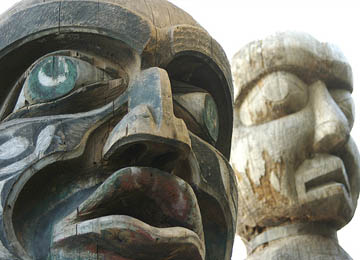Historic Haida Pit Burial - A simple, archaic burial for the commoners of this indigenous society

Haida carvings. Photo by Turbulent Flow
Despite some unpleasant connotations throughout history, pit burial was once commonplace among the indigenous people of the American northwest coast (modern-day British Columbia). The Haida people, rather than individual burial, would place the remains of people who had died into a large open pit behind their village.
Rather than embalmment, caskets or even cremation, these remains were left to nature, which, some written accounts report, resulted in a harsh stench in these villages. The practice ended sometime after white contact in the Americas, and it’s outlawed today.
Though this most simple of burials is somewhat unremarkable, what’s interesting about the Haida practices is that these practices were reserved for the commoners. Chiefs, shamans or warriors who had died received greater treatment. Because men of these classes were highly respected and recognized in the Haida society, their burial was a little more special.
For these special burials, the remains were preserved in a small wooden box — a box too small to hold an adult human body, so the remains were first crushed with clubs to fit inside! The box would be placed atop a totem pole in front of the longhouse of the man’s tribe. These totem poles displayed various various icons, which acted as guardians of the man’s spirit as it made its journey into the next world.
After death, the Haida believed a person’s soul was released and taken up by newborn members of the family. When a new child was born, they would watch its actions and features, searching for signs of whose soul they had inherited. Their home acted as a protection of these souls until death, when the cycle would repeat.
For more bizarre burial and funeral rituals around the world:
- Last Rites: A Catholic Send-Off
- Famadihana Death Ritual in Madagascar
- 19th Century Buddhist Self-Mummification



Comments